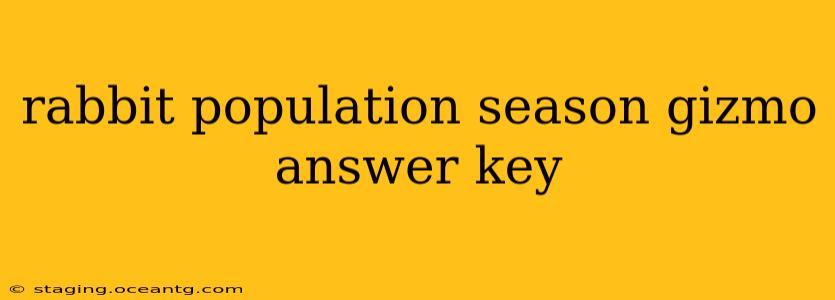Decoding the Rabbit Population Gizmo: A Comprehensive Guide
The Rabbit Population Gizmo is a popular educational tool used to simulate and understand population growth, carrying capacity, and environmental factors. This guide will walk you through understanding the Gizmo's mechanics, interpreting its results, and answering common questions. Because there isn't a single "answer key" for the Gizmo as its results depend on the user's inputs and choices, this guide will focus on understanding the underlying principles and how to approach different scenarios.
What is Carrying Capacity?
Carrying capacity is a crucial concept within the Gizmo. It represents the maximum population size of a species that an environment can sustain indefinitely, given the available resources like food, water, and shelter. The Gizmo lets you experiment with different carrying capacities and observe how the rabbit population responds. Understanding carrying capacity is key to correctly interpreting the simulation results. When the rabbit population exceeds the carrying capacity, you'll typically see a decrease in population due to resource limitations.
How do Limiting Factors Affect Rabbit Populations?
The Gizmo allows you to introduce various limiting factors, such as disease, predation, and food scarcity. Understanding how these factors influence rabbit population growth is critical. For example:
- Disease: A disease outbreak can dramatically reduce the rabbit population, potentially causing a population crash.
- Predation: Predators, like foxes or owls, will naturally keep the rabbit population in check, preventing it from exceeding the carrying capacity.
- Food Scarcity: Insufficient food supply limits the reproductive rate and survival of rabbits.
What are the Key Variables to Monitor?
While exploring the Gizmo, keep a close eye on several key variables:
- Population Size: The total number of rabbits at any given time.
- Growth Rate: The rate at which the rabbit population is increasing or decreasing.
- Resource Availability: The amount of food and other resources available to the rabbits.
- Limiting Factors: The presence and intensity of factors impacting the population.
How Does the Rabbit Population Change Over Time?
The rabbit population dynamics within the Gizmo are influenced by various interacting factors. Typically, you will observe periods of rapid growth followed by periods of stabilization or decline, depending on the interplay between birth rates, death rates, and limiting factors. Experiment with different scenarios to witness these variations.
What are Some Strategies for Maintaining a Stable Rabbit Population?
The Gizmo allows you to experiment with different strategies to manage the rabbit population. These could include manipulating resource availability, controlling predator populations, or implementing disease prevention measures. Observe the effects of each strategy and analyze which are most effective in maintaining a stable population size near the carrying capacity.
Interpreting Graphs and Charts:
The Gizmo provides visual representations of the rabbit population over time. Learning to interpret these graphs is essential. Pay attention to the shape of the curve—exponential growth will show a steep upward curve, while a stable population will show a relatively flat line near the carrying capacity. Significant drops indicate periods of population decline.
How Does the Gizmo Help Understand Real-World Ecology?
The Rabbit Population Gizmo serves as an excellent model for understanding real-world ecological concepts. It illustrates how populations are influenced by environmental factors and the importance of carrying capacity in maintaining biodiversity. The lessons learned from the Gizmo are applicable to other species and ecosystems.
By exploring these key concepts and engaging with the Gizmo's interactive features, you will gain a thorough understanding of rabbit population dynamics and the principles of ecology. Remember to experiment with different scenarios and analyze the results to fully grasp the concepts. This approach will provide a deeper understanding than simply searching for a pre-made "answer key."
